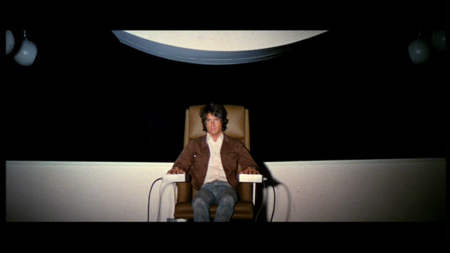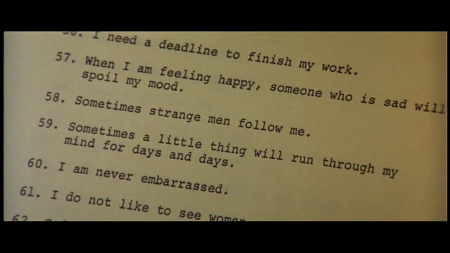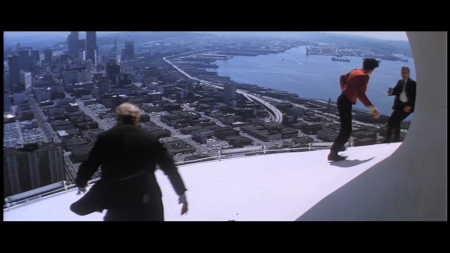A One-Way Ticket to Pakulaville
I watched THE PARALLAX VIEW, directed by Alan Pakula — excuse me, Alan *J* Pakula — because I figured it might serve as a surprise entry to Seventies Sci-Fi Week —
— one should always have Surprise Entries. I remember reading the line-up of a season of science fiction films programmed by David Cronenberg, and they were ALL surprise entries, from Robert Wise’s HELEN OF TROY (“Indistinguishable from FLASH GORDON” — nice try, but FLASH goes like a train — maybe SIGN OF THE CROSS would be a better fit) to TAXI DRIVER (“A better version of BLADE RUNNER than BLADE RUNNER.”)
— you see, I was remembering the Parallax Test scene and thought it was a movie about brainwashing, but I think that scene is probably just testing the subject’s emotional responses to words and images. It’s not the full Ludovico. To be a science-fiction film, the movie would have to take the speculations around Lee Harvey Oswald and Sirhan Sirhan and spin them into an elaborate speculative fiction. And the speculation would have to be based on altering present conditions. The Manchurian Candidate does this. It’s based on the way captured Americans were “brainwashed” — ie tortured into submission, in reality — during the Korean War, but it speculates that somebody could be mentally adjusted and become an unconscious assassin, a human bomb waiting for a post-hypnotic suggestion to trigger detonation. That phenomenon had never been witnessed — so far as we know — so the Condon book and Frankenheimer-Axelrod film could be termed sci-fi.
THE PARALLAX VIEW instead shows an organisation recruiting subjects who would make suitable lone gunmen, based on their psychological profiles, and also supplying patsies. No such organisation is known to exist — apart from possibly the CIA and a few organisations like it — but it certainly COULD exist. No adjustment of present social conditions or our understanding of scientific principles or our mastery of scientific techniques would be necessary for this film to come true.
Now I just scared myself.
The reason I misremembered the movie, which I have seen several times, is that it’s somehow elusive in the memory. And a little hard to concentrate on, as if the Hitchcockian, paranoid thriller were a slightly inapt match for Pakula’s offbeat, observational style (and we should maybe refer to the director as Pakula-Willis, since cinematographer Gordon Willis is such a central, essential contributor to Pakula’s best work). The script is by David Giler and Lorenzo Semple, with uncredited assist by Warren Beatty’s close buddy Robert Towne.
I had forgotten some good stuff — Hume Cronyn plays by far the best character (almost the only character, after Paula Prentiss’s one scene). I had forgotten there’s a hyperbolic barroom brawl that wouldn’t look out of place in a Hal Needham movie. I remembered that there was a car chase that’s similarly out-of-place. But the good action stuff is when Pakula defies genre by sitting the camera well back and calmly watching, chin resting on knuckles, as a human life is snuffed. The skirmish atop the Space Needle at the start, and the floundering fight in the flooding river, a huge damn venting a wall of spume in the background. The documentary distance adds a sense of reality, and therefore danger. (Obviously Pakula is doing this partly so he can cover up Beatty’s substitution by stunt double Craig Baxley — excuse me, Craig *R* Baxley — but the point is he makes a stylistic feature out of it.)
A different kind of distance afflicts our relationship with Warren Beatty’s character, a classic seventies alienated douchebag — Beatty cheerfully plays his more obnoxious traits to the hilt. The fact that he spends very little time in the movie with anyone he can relate to at all makes it a little hard to see him as other than an articulated shape. And I think the film has a hard job recovering from the Parallax Test in the middle, since it’s such a tour-de-force. We go from a montage masterpiece back into what is merely a very good movie. And nobody seems to know who is responsible. Don Record did the title designs and seems to have had a role designing it. John W. Wheeler edited the movie as a whole. Did they collaborate or was the whole sequence farmed out to Record?
It reminds me of Chuck Braverman’s amazing opening sequence to SOYLENT GREEN, which IS a seventies sci-fi movie.
Now go do what you have to do.



July 31, 2015 at 11:37 am
I rewatched this only last week, and was put in the mood for it by finally getting round to Kaufmans’s Bodysnatchers… so I’ve no problem with the idea of it as an example of Seventies’ sci-fi. (I then moved on to Network. Same.) Before that montage even starts we’ve already crossed over into the fantastic of course, via the viewing room itself. A recruitment agency like this might exist, but would it really fork for a giant hall with a moving ceiling just to show one schlub a film? It’s like Ned Beatty dimming the lights. It signals you’re about to peirce the veil and enter the monolith.
And then there’s the play with Beatty’s identity which you allude to – the sci-fi existentialism of finding yourself in a society that can define your role regardless of compliance or even the facts.
It’s wonderful how little these films eff around. I also love, for example, the economy of Death Race 2000’s opening shots – sports footage of a happy crowd waving stars, stripes and swastikas – all now happily robbed of significance.
July 31, 2015 at 12:36 pm
Death Race 2000 really IS a punk film…
Mike Sutton just suggested Pakula’s Rollover as another scifi film, although again, I *think* it is positing something that could happen under present-day circumstances.
Network is satire, which of course is a genre which relates to and interpenetrates sci-fi. Both often start from the premise of “If this kind of thing keeps on…”
July 31, 2015 at 2:36 pm
Clearly “Don Draper” made that Parallax film.
The notion of Warren Beatty as an “articulated shape” is interesting in that Pakula’s film comes right in the middle of his career arc as Hollywood’s prime “A Whole Lot More Than An Actor.” He has been intensely involved in politics for years and years and years. Many claim he’s largely responsible for turning Bobby Kennedy from a Joe McCarthy aide into the leading Liberal of his time. Bobby’s death clearly haunts Warren — who re-enacts it in Bulworth.
He has informed IMDB that his still-untitled long-aborning Howard Hughes movie has been “completed.” I expect we’ll see it come Christmas. Can’t wait.
Meanwhile leave us not forget —
July 31, 2015 at 4:59 pm
Nice to see a little love for Soylent Green. Those opening titles are very well done (arguably the best thing in the movie), and though it’s pretty clunky at times and the shock ending is the least shocking thing in it, I always liked how bleak it was willing to be. Edward G. Robinson’s assisted suicide is still powerful, partly because Robinson really was dying at the time (and Heston knew it), and partly because Heston’s character had never seen nature before, and never realized what he had missed. For me, the shocking moment in the film isn’t when we realized corporate cannibalism was now how things are done, it’s the reason for it — the seas are dead. That’s much grimmer than what Heston is so het up about.
July 31, 2015 at 5:01 pm
Joe Esterhaas tells us that Beatty and Robert Towne liked shagging girls in the same hotel room together. “You don’t need to get that close to a star,” he advises.
Beatty decided he had to choose between politcs and screwing lots of women — although JFK seems to have both had and eaten that particular cake.
Fiona’s verdict on Beatty — “If I met him during his heyday… I wouldn’t be tempted. But then maybe it’s different in person.”
Needless to say, her taste is unconventional.
July 31, 2015 at 5:14 pm
I was privileged to hear original author Harry Harrison talk about Soylent Green, and the changes from the book (Make Room! Make Room!), so I should really write about that one and try to record what I remember.
July 31, 2015 at 6:29 pm
Shirley Maclaine’s brother and The Creature From the Haunted “Pulling train” ? Very Rob Lowe. Warren is quite upfront about his womanizing in Shampoo , which was co-scripted by Towne.
And have you met Warren’s transgender son?
July 31, 2015 at 8:11 pm
Yes, Beatty Jnr seems an admirable young chap.
Beatty is at least discrete, and has attested that if you ever read any comment by him about any woman he’s known. you can be sure the quote was invented by some hack. A gent. An insatiable seducer, but a gent.
July 31, 2015 at 9:06 pm
He’s kissed and kissed and kissed again — but never told.
July 31, 2015 at 9:22 pm
An honorable lech.
July 31, 2015 at 9:46 pm
I take it you know about the more sci-fi ending Chayefsky considered for Network. It’s in the (excellent) book “Mad As Hell: The Making of Network” but the relevant part is repeated here
http://birthmoviesdeath.com/2014/02/18/the-unwritten-dystopic-ending-of-paddy-chayefskys-network
July 31, 2015 at 10:10 pm
I hadn’t heard that (and I’ve read lots of Chayefsky interviews). Basically Wag the Dog, then. But with more and better dialogue.
July 31, 2015 at 11:56 pm
And then there’s Winter Kills which is like a kaleidoscopic carousel ride with Parallax and Manchurian Candidate spinning till they’re giddy. I’m so impressed that you got to hear Harry Harrison. I wish Hollywood had franchised his Stainless Steel Rat instead of all those Marvels.
August 1, 2015 at 10:27 am
Winter Kills is like the love child of Parallax and The President’s Analyst. Marvelous.
2000AD did a decent comic book version of The Stainless Steel Rat, I think the only time they ever used a novel as source (and paid for it). And they made the hero look like James Coburn, which was fine casting. Angelina looked something like Ornella Muti.
The big difficulty with the first book is he changes his face halfway through — hard to get around. But I agree, the “To Catch a Thief in Space” high concept is eminently worthy.
August 1, 2015 at 1:48 pm
It’s a shame we haven’t hear anything from William Richert lately. Winter Kills and Success are superb. A Night in the Life of Jimmy Reardon less so. But that film cemented his friendship with Gus Van Sant and secured him a key role in Gus’ remake of Chimes at Midnight
August 1, 2015 at 1:51 pm
August 1, 2015 at 4:00 pm
And speaking of “Mind Control” here’s a scene from John Carpenter’s They Live starring the great and-just-now-late Roddy Piper.